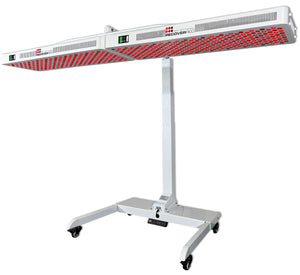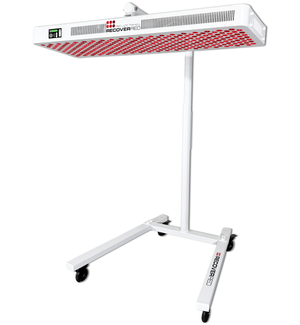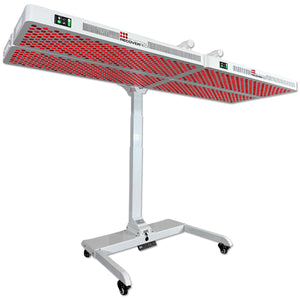
Total knee replacement surgery, while life-changing for many, often comes with an extended recovery period, leaving patients with significant bruising, soreness, and a noticeable scar on the knee. However, a promising and non-invasive solution has emerged in recent years – Red Light Therapy (RLT). In this article, we will explore how RLT can speed up the healing process, reduce bruising and soreness, and minimize scarring, offering patients a more comfortable and aesthetically pleasing recovery journey.
Speeding Up the Healing Process
Red Light Therapy employs low-level red and near-infrared light to stimulate cellular function, increase blood flow, and reduce inflammation. When applied to postoperative recovery, this therapy can work wonders. Here's how:
- Enhanced Cellular Regeneration: RLT prompts mitochondria, the powerhouses of our cells, to produce more adenosine triphosphate (ATP), fueling the cells for improved recovery. This boost in cellular energy accelerates the healing process, allowing for faster tissue repair. [1]
- Increased Blood Flow: The red and near-infrared light penetrates deep into the tissues, promoting vasodilation, which widens blood vessels and enhances circulation. This increased blood flow delivers more oxygen and nutrients to the affected area, facilitating quicker recovery and reducing pain.
- Reduced Inflammation: Inflammation is a natural response to surgery, but excessive inflammation can hinder the healing process. RLT has anti-inflammatory properties, helping to modulate the inflammatory response and prevent it from becoming overwhelming. [2]
Reducing Bruising and Soreness
Bruising and soreness are common after total knee replacement surgery. RLT can significantly alleviate these discomforts:
- Decreased Swelling: RLT minimizes swelling by reducing inflammation and improving lymphatic drainage. As a result, the appearance of bruising is lessened, and patients experience reduced discomfort.[2]
- Pain Relief: Many patients report decreased pain levels after RLT sessions. The therapy stimulates the release of endorphins, the body's natural painkillers, providing much-needed relief during the recovery process. [3]
- Improved Range of Motion: By reducing stiffness and promoting muscle relaxation, RLT enables patients to regain their range of motion more quickly. This, in turn, minimizes the discomfort associated with limited mobility.
Reducing Scarring and Collagen Production
A concern for many individuals undergoing knee replacement surgery is the resulting scar. RLT can help in the following ways:
- Collagen Regulation: RLT regulates collagen production, a crucial component in scar formation. By preventing excessive collagen buildup, RLT ensures that scars are less raised and conspicuous. [4]
- Scar Tissue Remodeling: RLT has been shown to aid in the remodeling of existing scar tissue. By encouraging the breakdown of old, dense scar tissue and promoting the growth of newer, healthier tissue, RLT helps achieve a more cosmetically appealing result.
- Improved Skin Texture: The therapy stimulates the production of elastin and fibroblasts, essential for maintaining skin's elasticity and suppleness. This leads to smoother, softer scar tissue, making it less noticeable.
Using RLT During Healing
To reap the full benefits of RLT during your knee replacement surgery recovery, it's important to consult with your healthcare provider and adhere to their recommendations. They can guide you on the appropriate frequency and duration of RLT sessions. Additionally, RLT devices are available for home use, making it convenient for patients to incorporate this therapy into their daily routines.
Conclusion
In conclusion, the path to recovery after total knee replacement surgery can be challenging, but with the innovative approach of Red Light Therapy (RLT), there is now a powerful tool to help you on your journey. By expediting the healing process, reducing bruising and soreness, and minimizing scarring, RLT offers a holistic solution to enhance your recovery experience.
At Recover Red, we understand the importance of effective postoperative care. That's why we offer a range of high-quality RLT products on our website, designed to help you harness the healing potential of red and near-infrared light from the comfort of your own home. Whether you're looking to speed up your recovery, alleviate discomfort, or improve the appearance of your scars, our RLT products can be a valuable addition to your rehabilitation plan.
Remember to consult with your healthcare provider to determine the most suitable RLT regimen for your individual needs. With Recover Red by your side, you can embrace your recovery journey with confidence, knowing that you have a trusted partner in optimizing your healing process.
References:
- Rohringer, S., Holnthoner, W., Chaudary, S., Slezak, P., Priglinger, E., Strassl, M., Pill, K., Mühleder, S., Redl, H., & Dungel, P. (2017). The impact of wavelengths of LED light-therapy on endothelial cells. Scientific reports, 7(1), 10700. https://doi.org/10.1038/s41598-017-11061-y
- Hamblin M. R. (2017). Mechanisms and applications of the anti-inflammatory effects of photobiomodulation. AIMS biophysics, 4(3), 337–361. https://doi.org/10.3934/biophy.2017.3.337
- Al-Quisi, A. F., Al-Anee, A. M., Al-Jumaily, H. A., Bahr, E. F., & Finjan, D. A. (2019). Efficacy of the LED Red Light Therapy in the Treatment of Temporomandibular Disorders: Double Blind Randomized Controlled Trial. Pain research and treatment, 2019, 8578703. https://doi.org/10.1155/2019/8578703
- Li, W. H., Seo, I., Kim, B., Fassih, A., Southall, M. D., & Parsa, R. (2021). Low-level red plus near infrared lights combination induces expressions of collagen and elastin in human skin in vitro. International journal of cosmetic science, 43(3), 311–320. https://doi.org/10.1111/ics.12698





